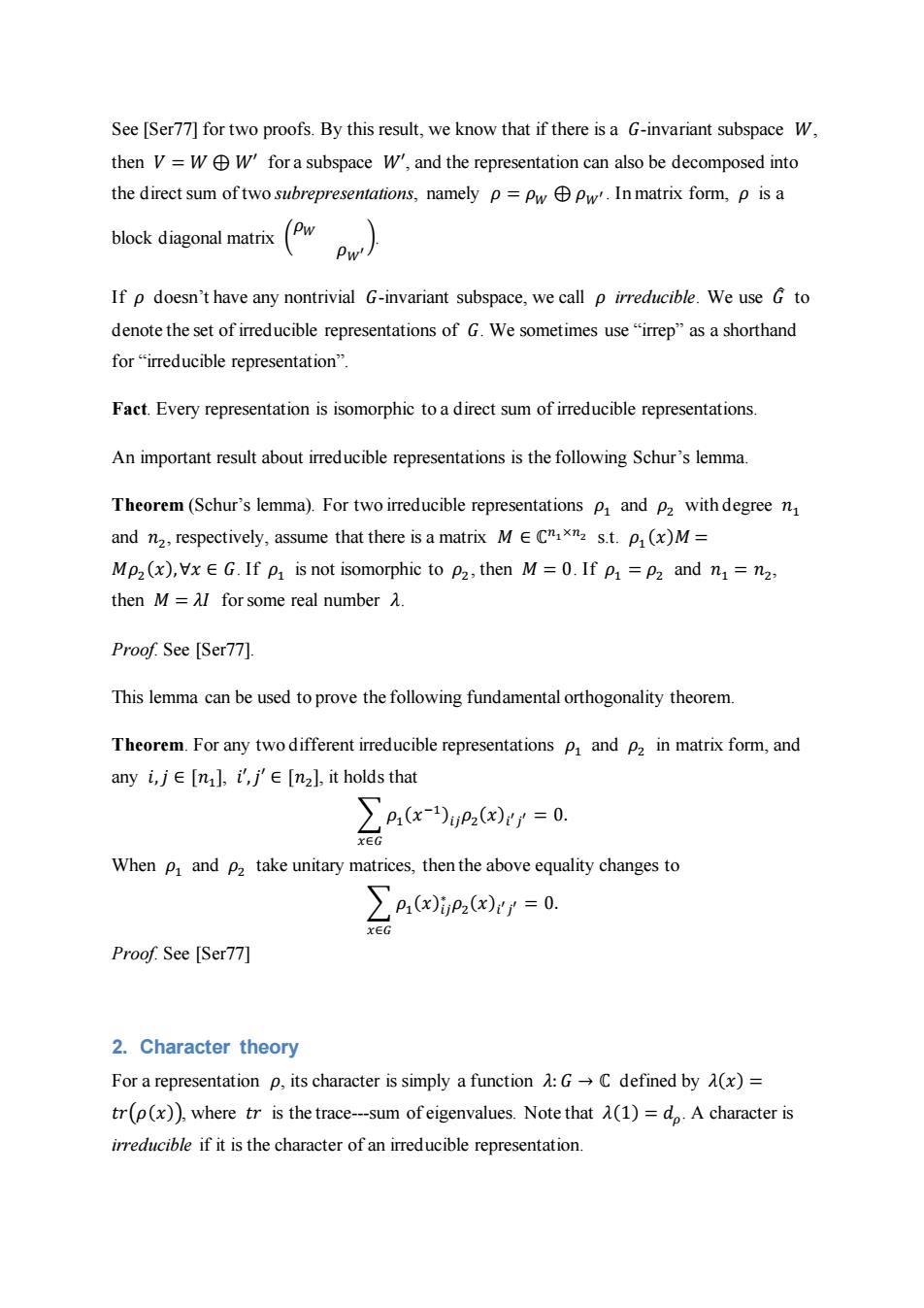正在加载图片...

See [Ser77]for two proofs.By this result,we know that if there is a G-invariant subspace W, then V=Ww'for a subspace w',and the representation can also be decomposed into the direct sum of two subrepresentations,namely p =pw pw'.In matrix form,p is a block diagonal matrix Pw If p doesn't have any nontrivial G-invariant subspace,we call p irreducible.We use G to denote the set of irreducible representations of G.We sometimes use"irrep"as a shorthand for"irreducible representation". Fact.Every representation is isomorphic to a direct sum of irreducible representations. An important result about irreducible representations is the following Schur's lemma. Theorem(Schur's lemma).For two irreducible representations p and p2 with degree n and n2,respectively,assume that there is a matrix M E Cmxnz s.t.p(x)M= Mpz(x),Vx EG.If p is not isomorphic to p2,then M=0.If p=P2 and n=n2, then M=AI for some real number A. Proof.See [Ser77]. This lemma can be used to prove the following fundamental orthogonality theorem. Theorem.For any two different irreducible representations P and P2 in matrix form,and any i,je [n],i',j'E [n2],it holds that 2px1P2(x)7=0. XE When p and p2 take unitary matrices,then the above equality changes to p()1=0. XEG Proof.See [Ser77] 2.Character theory For a representation p,its character is simply a function A:GC defined by A(x)= tr(p(x)),where tr is the trace---sum of eigenvalues.Note that A(1)=do.A character is irreducible if it is the character of an irreducible representation.See [Ser77] for two proofs. By this result, we know that if there is a 𝐺-invariant subspace 𝑊, then 𝑉 = 𝑊 ⊕ 𝑊′ for a subspace 𝑊′, and the representation can also be decomposed into the direct sum of two subrepresentations, namely 𝜌 = 𝜌𝑊 ⊕ 𝜌𝑊′ . In matrix form, 𝜌 is a block diagonal matrix ( 𝜌𝑊 𝜌𝑊′ ). If 𝜌 doesn’t have any nontrivial 𝐺-invariant subspace, we call 𝜌 irreducible. We use 𝐺̂ to denote the set of irreducible representations of 𝐺. We sometimes use “irrep” as a shorthand for “irreducible representation”. Fact. Every representation is isomorphic to a direct sum of irreducible representations. An important result about irreducible representations is the following Schur’s lemma. Theorem (Schur’s lemma). For two irreducible representations 𝜌1 and 𝜌2 with degree 𝑛1 and 𝑛2 , respectively, assume that there is a matrix 𝑀 ∈ ℂ 𝑛1×𝑛2 s.t. 𝜌1 (𝑥)𝑀 = 𝑀𝜌2 (𝑥),∀𝑥 ∈ 𝐺. If 𝜌1 is not isomorphic to 𝜌2 , then 𝑀 = 0. If 𝜌1 = 𝜌2 and 𝑛1 = 𝑛2 , then 𝑀 = 𝜆𝐼 for some real number 𝜆. Proof. See [Ser77]. This lemma can be used to prove the following fundamental orthogonality theorem. Theorem. For any two different irreducible representations 𝜌1 and 𝜌2 in matrix form, and any 𝑖,𝑗 ∈ [𝑛1 ], 𝑖′,𝑗′ ∈ [𝑛2 ], it holds that ∑ 𝜌1 (𝑥 −1 ) 𝑖𝑗𝜌2 (𝑥) 𝑖 ′ 𝑗 ′ 𝑥∈𝐺 = 0. When 𝜌1 and 𝜌2 take unitary matrices, then the above equality changes to ∑ 𝜌1 (𝑥) 𝑖𝑗 ∗ 𝜌2 (𝑥) 𝑖 ′ 𝑗 ′ 𝑥∈𝐺 = 0. Proof. See [Ser77] 2. Character theory For a representation 𝜌, its character is simply a function 𝜆: 𝐺 → ℂ defined by 𝜆(𝑥) = 𝑡𝑟(𝜌(𝑥)), where 𝑡𝑟 is the trace---sum of eigenvalues. Note that 𝜆(1) = 𝑑𝜌 . A character is irreducible if it is the character of an irreducible representation